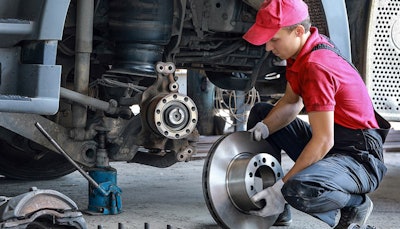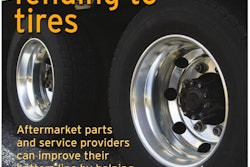
In 2019, almost two-thirds of the vehicles taken out of service during the Commercial Vehicle Safety Alliance (CVSA) International Roadcheck had violations related to brake systems, tires and wheels and brake adjustment. The statistic emphasizes the importance of foundational maintenance and its role in keeping vehicles on the road and operating safely.
With those results in mind, Bendix (Bendix Commercial Vehicle Systems LLC and Bendix Spicer Foundation Brake LLC) wants to make it easier for fleets and owner-operators to plan for and accomplish basic maintenance tasks with proactive advice on tire and brake systems in time for this year’s International Roadcheck.
The 2020 Roadcheck takes place Sept. 9-11, after being postponed from its original dates of May 5-7 because of the coronavirus pandemic. During the three-day inspection and enforcement initiative, CVSA-certified inspectors in Canada, Mexico and the U.S. will conduct commercial motor vehicle and driver inspections at weigh or inspection stations, examining both driver operating requirements and vehicle mechanical fitness.
“During the 2019 Roadcheck initiative, nearly 18 percent of inspected vehicles in the U.S. were removed from service because of critical violations related to either drivers or vehicles. In fact, the majority of those violations were attributed to either braking systems, tires and wheels and brake adjustment,” says Fred Andersky, Bendix director – demos, sales and service training.
“This year, inspectors will again scrutinize braking systems and wheel-end components, while also putting a special focus on examining driver requirements. Still, it’s important to note that many of the issues that turn up in these inspections — such as improper tire pressure or brakes in need of adjustment — can be easily prevented with simple, routine maintenance. Also critically important is a caliber of technician training that ensures these procedures are performed properly and at the right time,” Andersky says.
With vehicle braking systems, wheel-ends and tires under scrutiny, Bendix shares key points on inspecting and maintaining these crucial components.
Checking the tires
Roadcheck tire inspections highlight the importance of maintaining proper tire pressure: Industry research shows about 90 percent of tire failures can be attributed to underinflation, and nearly half of all emergency service road calls are tire-related.
“When tires are underinflated, it generates higher internal running temperatures, which can trigger tire blowouts, besides putting unnecessary stress, and wear and tear on the tires,” says Jon Intagliata, Bendix product group director, Trailer Controls. “In fact, the American Trucking Associations’ Technology & Maintenance Council estimates that 20 percent underinflation can shorten a tire life by 30 percent.”
Using a system such as the SmarTire tire pressure monitoring system (TPMS) by Bendix CVS — or the SmarTire Trailer-Link TPMS by Bendix CVS for trailers — can help reduce risk by providing real-time pressure alerts to the driver. Bendix SmarTire systems use a wheel-mounted sensor that continuously monitors temperature and pressure, allowing for tire alerts that compensate for changing operating conditions. The alerts can also point to other potential wheel-end issues that lead to high tire temperatures, such as a dragging brake, the company says.
Tires also impact the performance of advanced safety components and technologies, including reduced stopping distance (RSD)-compliant brakes, air disc brakes, full stability and advanced driver assistance systems such as Bendix Wingman Fusion.
Brake system checkups
Brake systems and brake adjustment contribute to a range of issues that are easily averted through regular pre-trip inspections and preventive maintenance. Drivers should always conduct standard walk-arounds before hitting the road, looking for visible brake system problems such as loose hoses or damaged brake components — air chambers or pushrods, for example.
In the shop, Bendix says air brake system inspections should include the following — all of which relate directly to items inspected during Roadcheck:
- Conducting a 90- to 100-psi brake application and listening for leaks
- Measuring chamber stroke at each wheel-end to ensure proper brake adjustment
- Examining friction for good condition and minimum thickness
- Measuring/inspecting each rotor and drum for wear and heat cracking and/or leopard spotting
Brake friction is another essential component to check for compliance, whether during maintenance or pre-trip. This means inspecting for issues including lining cracks, missing portions of the lining, oil or grease contamination of the lining, and compliant friction lining thickness.
“When you do need to replace air disc brake pads or drum brake shoes, select components that will ensure the original equipment manufacturer (OEM) requirements are met, so that your vehicle remains compliant with the standards required of RSD braking systems,“ says Keith McComsey, director of marketing and customer solutions at Bendix Spicer Foundation Brake (BSFB).
“Not all friction that is marketed as acceptable under today’s RSD regulations will actually perform to that standard, so Bendix recommends replacing like-for-like OEM friction. This is the best way to maintain your vehicle’s braking performance in stopping distance and wear when replacing linings on vehicles equipped with RSD brakes,” McComsey says.
In addition, Bendix recommends remanufactured drum brake shoes that have been coined back to their OEM-engineered shape, as opposed to those that have simply been relined with new friction. Relining a shoe that’s been exposed to the extreme force and temperature changes of normal use without having been coined can lead to reduced stopping power and premature wear.
“Don’t let inferior friction or a twisted shoe undercut the stopping power of a high-performance brake. Using OEM-quality parts ensures you will achieve the best and safest performance from your braking system,” McComsey says. “Also keep in mind, there’s a clear link between the braking system and connected safety systems: A full-stability or collision mitigation system will be negatively affected if brakes aren’t performing at their peak.”
Fleets spec’ing drum brakes and incurring repeated violations due to out-of-adjustment brakes might consider air disc brakes instead, McComsey says, citing the Bendix ADB22X air disc brake as an example.
“The ADB22X includes an internal self-adjustment mechanism that can help lower the risk of brakes being found out of adjustment during inspection, which can affect Compliance, Safety, Accountability (CSA) scoring,” he says.










